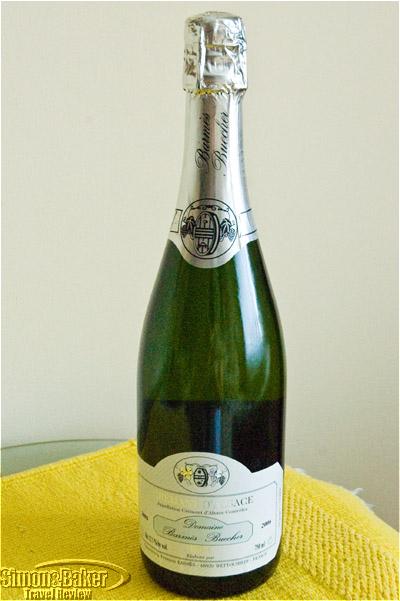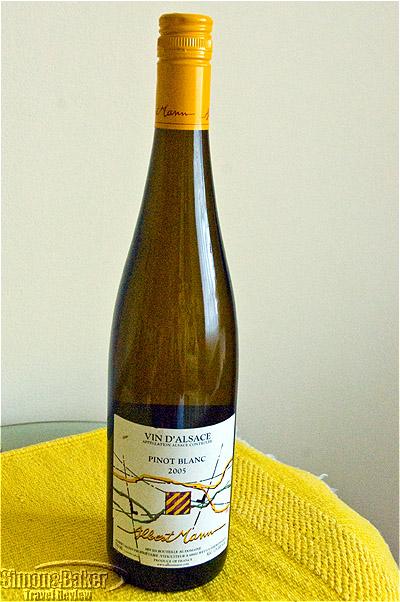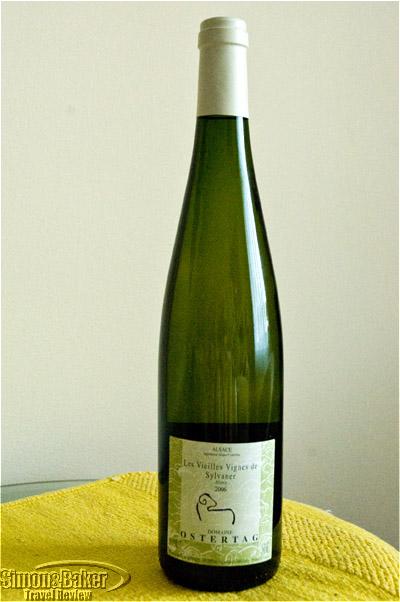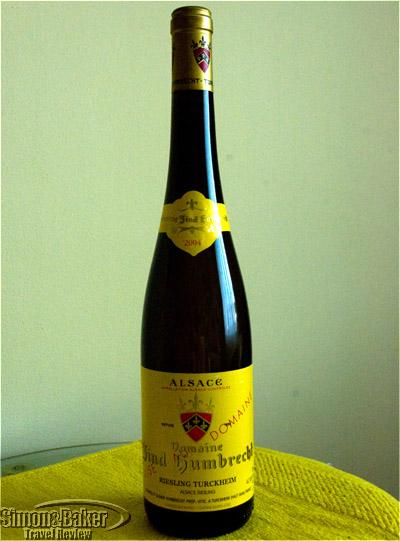by Editor | Dec 22, 2008 | Food and Wine

Lee Fuller
In our family, the inspiration behind a wine tasting usually comes from our very own wine expert, my son Lee Fuller. This latest tasting on a recent afternoon, focused on biodynamic wines of Alsace, was no exception.
When it comes to his food supply, Lee is uncompromisingly green. He is also of one mind with Henry David Thoreau (“What is the use of a fine house if you haven’t got a tolerable planet to put it on?”); although the conversation that led to this tasting was more along the lines of: “what is the use of a fine wine, if you haven’t got a tolerable planet to drink it on?” This naturally led us to consider the dedication of a number of Alsatian vintners who have been producing biodynamic wines for the past two decades, long before it became fashionable.
What is biodynamics? An ultra-organic wine-making method that focuses not only on producing naturally fermented wines from organic grapes but also on healing the vineyard. The biodynamic vintner sees his vineyard: the vines, the soil in which they grow and the surrounding fauna and flora as an interdependent ecological whole. Where biodynamics goes beyond other methods of organic or sustainable agriculture is in its understanding that farming should be aligned with the spiritual forces of the universe. It is a return to agricultural methods that prevailed on the planet from time immemorial until the development of industrial farming in the past sixty years. In the biodynamic vineyard sowing and harvesting are again timed to the rhythm of the sun, the moon and the planets. Soil and crop treatment are homeopathic, using natural fertilizers such as composted animal manure, cultivating the soil and planting ground cover rather than using chemical herbicides. Plants other than vines are encouraged to grow around the vineyard to promote biodiversity by attracting beneficial insects.
There is no doubt that the biodynamic process is beneficial to the planet; and to the wine drinker who is no longer at risk of ingesting chemical residues that can end up in the wine. But… is the resulting wine any good?
That is the question we set out to address, in part, with a tasting of four biodynamic Alsatian wines.
Biodynamic practices are very labor intensive and require a huge long-term commitment on the part of the grower. Therefore we selected for our tasting an assortment of wines from four wineries that have been at the forefront of biodynamic viticulture for decades. This was our line up:

Domaine Barmes-Buecher, Crémant d’Alsace 2006 (sparkling)
Approximate retail price: $19.99
Since we often drink brut sparkling wines as an apéritif, we started with a Crémant d’Alsace Brut 2006, from Domaine Barmès-Buecher (crémant is the official appellation that designates French sparkling wines produced outside the Champagne region). It was very pale in color with gentle effervescence in the glass that developed in the mouth. We found it unusually mild for a brut. Made from a blend of Chardonnay and Pinot Blanc, its aroma was fruity with a hint of berries. On the palate, nectarine dominated. This was a lovely, refreshing sparkler that stood best on its own. A good choice for relaxed sipping on a warm summer’s afternoon, or by the fire on a winter’s evening.

Albert Mann, Pinot Blanc 2005
Approximate retail price: $15.99
This was a delightful classic Alsace Pinot Blanc! Made from 100 percent Pinot Blanc grapes, it was very pale with a lime-colored hue and a fresh floral and herbal nose that hinted at lemon basil. It evolved to an Anjou pear palate with undertones of ripe citrus. The pear taste lingered through the finish. Overall a dry, well balanced wine that we enjoyed on its own and with light hors-d’oeuvres. It also held its own remarkably well with a pungent cheese and nuts. I intend to serve it soon with grilled fish.

Domaine Ostertag, Sylvaner “Vielle Vignes” 2006
Approximate retail price: $19.99
Made of 100 percent Sylvaner grapes coming from 50 to 70 year-old vines, this wine was a treat. A little paler than the usual Sylvaner, it intrigued us immediately with an unusual nose reminiscent of freshly baked brioche. It became pleasantly fruity in the mouth, predominantly apple. The finish was subdued, slightly mineral, with well-balanced acidity. We enjoyed it with mild cheeses and cold ham. It also did very well later on with a seafood salad. A versatile pleaser that I will keep on hand for varied occasions.

Domaine Zind-Humbrecht, Riesling “Turckheim” 2004
Approximate retail price: $39.99
This was an opulent wine with lots of personality. Its very aromatic fruity nose mellowed after a while to a light citrus scent with hints of caramel. It evolved from pleasant sharpness on the tongue to a vibrant palate of peaches and tropical fruits laced with mineral accents. It had a long, mouthwatering finish that worked well with our goat cheese, and also with smoked salmon. Made of 100 percent Riesling grapes, this was a powerful wine that I look forward to serving this winter with a convivial platter of choucroute garnie.
We declared our experiment successful. The biodynamic Alsatian wines we sampled were delicious, loaded with personality, and competitively priced against their conventional counterparts. We will definitely seek them out from now on; and enjoy the knowledge that our libations are helping the planet.
Photos and article by Josette King, in cooperation with Lee Fuller, oenophile and wine collector.
by Editor | Mar 10, 2008 | Food and Wine
By Natalie MacLean

Natalie MacLean, author, Red, White and Drunk All Over
Dinner with wine used to be simple. The rule was white wine with white meat and red wine with red meat. But most of us don’t just eat meat and potatoes or drink claret and chablis these days.
With modern fusion cuisine and wines from new regions around the world, the choices – and confusion – are great. One new school of thought is that any wine goes with any dish. However, most of us don’t put ketchup on our ice cream for the same reason as we don’t drink a delicate white wine with a hearty meat dish or a powerful red wine with sole – they are mismatched flavors and textures.
When the marriage of food and wine works well, each enhances the other, making the meal greater than if you had consumed them separately. That’s why the following classic matches have survived the changes in food fashion: stilton with port, foie gras with sauternes, boeuf bourguignon with Burgundian pinot noir and goat cheese with sauvignon blanc.
It helps to start with the basic principles of food and wine pairing as they still provide a basis for experimenting with new world cuisine. One of the most important elements to harmonize between wine and food is flavor. For example, a tangy tomato-based pasta sauce requires a wine with comparable acidity. Without this balance between the acidity of the dish and the wine, the partner with lower acidity tastes flabby and dull, while the other, too tart.
To find an acidic wine, you can chose one that is made in the same area as the food. Years of matching the regional cuisine and wine as well as similar soil and climatic conditions make this a safe bet. For example, you could pair a tomato sauce fettuccine with a Tuscan chianti. Or you can select a wine from a cool climate where the grapes don’t ripen to great sweetness, and maintain their tart, tangy edge. Crisp New Zealand sauvignon blancs and French chablis serve these dishes well.
Acidic wines also work well with salty dishes. For example, oysters are both salty and briny with an oily mouth-coating texture that can smoother most wines. However, a sparkling wine from California, a Spanish cava or French champagne can both refresh and cleanse your palate when eating fish.

Bubblies also work well with spicy foods. Hot spice in Asian, Thai, curry and chili pepper dishes can numb the palate. Many of these foods also have high acidity from citrus ingredients such as lime juice as well as sweetness. Therefore, you need a wine with an acidic backbone as well as a touch of sweetness such as an off-dry California sparkling wine with lots of fruit.
While off-dry, acidic wines go well with many dishes, the two most difficult wines to pair with food are also the two most popular: chardonnay and cabernet sauvignon. New World chardonnays can be oaky, buttery, flavorful wines that overwhelm many dishes. But you can still enjoy chardonnay with your meal. Pair it with butter and cream sauces to marry similar textures and flavors.
Conversely, cabernet sauvignons can have bitter dark fruit flavours with mouth drying tannins (the same sensation you get from drinking well-brewed tea). Therefore, they find their happiest match in foods with juicy proteins such as a rare steak. The protein softens the tannin making the wine taste smooth and fruity. Steaks done with crushed black peppercorns sensitize your taste-buds, making the wine taste even more fruity and robust.
However, the way in which the dish is prepared also has an impact. A well-done steak, for example, may taste too dry with a tannic cabernet.Proteins are also at work with the marriage of wine and cheese, the cocktail classic. Red wines tend to go better with hard cheeses such as blue cheese as they can accommodate more tannins. However, whites suit soft cheeses such as brie and camembert as the creamier textures require more acidity for balance.
Game birds such quail, pheasant, turkey, duck, squab and guinea hen have earthy flavors that are more robust than chicken. Wild game often goes better with racy red wines that have a gamy quality to them, the classic being Burgundian pinot noir. The flavors of pinot noir — plum, cherry, mushrooms, earth and even barnyard (that’s a positive adjective) – accentuate the same gamy flavors in the food. Other wine options for game birds include Spanish rioja, Oregon pinot noir and lighter-style Rhône Valley wines such as Côte-Rôtie.
One of the most challenging flavors to balance is sweetness. Dishes with a touch of sweetness such as glazed pork do well with off-dry wines such as riesling and chenin blanc. However, rich desserts such as chocolate and crème brulée demand a wine that is sweeter than the dessert, or the wine will taste thin, even bitter. Sweet wines such as sauternes, Canadian icewine, late harvest wines and port will work not only for their sweetness but also for their unctuous texture.
Your best source of food and wine matching is your own palate. Experiment with different combinations to discover not only what makes a perfect pairing for you, but also to broaden your range of possibilities. As the author Alexis Lichine observed, “There is no substitute for pulling corks.”
This article is reprinted with permission from Natalie MacLean’s free e-newsletter. Natalie MacLean is the author of Red, White and Drunk All Over: A Wine-Soaked Journey from Grape to Glass. She was named the World’s Best Drink Writer for the articles and wine picks in her free wine newsletter available at http://www.nataliemaclean.com/.















